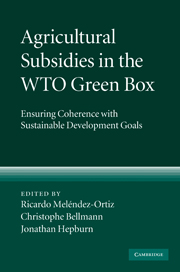Book contents
- Frontmatter
- Contents
- List of contributors
- Preface
- Acknowledgements
- List of abbreviations
- 1 Overview
- PART I The recent evolution of agricultural trade policy reform
- 2 The historical context of the green box
- 3 Doha Round negotiations on the green box and beyond
- 4 The reform of the EU's Common Agricultural Policy
- 5 Farm policy reform in the United States: past progress and future direction
- 6 Agricultural trade policy reform in Japan
- PART II The focus, extent and economic impact of green box subsidies
- PART III Green box subsidies and developing countries
- PART IV Green box subsidies and the environment
- PART V Looking forward: how can change take place?
- Appendix: Text of Annex 2 of the WTO Agreement on Agriculture (“the green box”)
- Index
6 - Agricultural trade policy reform in Japan
from PART I - The recent evolution of agricultural trade policy reform
Published online by Cambridge University Press: 03 May 2010
- Frontmatter
- Contents
- List of contributors
- Preface
- Acknowledgements
- List of abbreviations
- 1 Overview
- PART I The recent evolution of agricultural trade policy reform
- 2 The historical context of the green box
- 3 Doha Round negotiations on the green box and beyond
- 4 The reform of the EU's Common Agricultural Policy
- 5 Farm policy reform in the United States: past progress and future direction
- 6 Agricultural trade policy reform in Japan
- PART II The focus, extent and economic impact of green box subsidies
- PART III Green box subsidies and developing countries
- PART IV Green box subsidies and the environment
- PART V Looking forward: how can change take place?
- Appendix: Text of Annex 2 of the WTO Agreement on Agriculture (“the green box”)
- Index
Summary
Introduction
The Japanese economy is under restructuring to cope with globalization. Agriculture is not exempt from this process. Rather, agricultural reform should be encouraged because it has lagged behind other sectors that have been liberalized relying on international trade. Japanese agriculture, in particular rice farming, has been protected by border measures and domestic price supports, but Japan is one of the largest agricultural importers in the world. Despite the high level of agricultural protection in Japan, the Japanese food self-sufficiency ratio declined to 39 per cent on a calorie basis in 2006. It appears that the protection policy has played no role in strengthening Japanese agriculture and has impeded inter-sectoral adjustment.
According to the Basic Law on Food, Agriculture and Rural Area established in 1999, which replaced the 1961 Agricultural Basic Law, the Japanese Government revised the New Basic Plan of Food, Agriculture and Rural Areas in March 2005. This indicates guidelines for agricultural policies 10 years from now. The plan contains, among other things, the target level for Japan's food self-sufficiency ratio, policies for structural reform, stabilization schemes for agricultural income and ideas for promoting effective use of agricultural land.
In 2007, a new agricultural policy scheme was launched in Japan to introduce a direct payment for land-extensive farming under the Farm Management Stabilization Programme. This aims to guarantee large-scale farmers a certain level of income, regardless of the commodities produced.
- Type
- Chapter
- Information
- Agricultural Subsidies in the WTO Green BoxEnsuring Coherence with Sustainable Development Goals, pp. 121 - 134Publisher: Cambridge University PressPrint publication year: 2009
- 1
- Cited by



